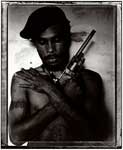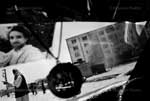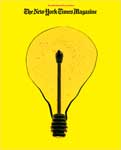
The New York Times Magazine’s Year in Ideas issue is always a fascinating read. A lot of these topics were already posted here on my blog from other news sources as the year went on, but I want to highlight some of my favorites with links to the Magazine:
Bicycle Helmets Put You at Risk
Walker decided to find out — putting his own neck on the line. He rigged his bicycle with an ultrasonic sensor that could detect how close each car was that passed him. Then he hit the roads, alternately riding with a helmet and without for two months, until he had been passed by 2,500 cars. Examining the data, he found that when he wore his helmet, motorists passed by 8.5 centimeters (3.35 inches) closer than when his head was bare. He had increased his risk of an accident by donning safety gear.
The Boomerang Drone
When the Phantom Sentinel takes flight, it looks like an awkward boomerang — a set of three small blades. It spins in a circle, faster and faster as it ascends into the sky. Then, when it reaches about 50 feet, it whirls so fast that something remarkable happens: it vanishes right before your very eyes.
Hyperopia
Kivetz also interviewed 69 students from Columbia University who had returned one week previously from winter break and found that as a group they were split in roughly equal numbers between regret and contentment for having worked or partied. But when Kivetz talked to alumni who graduated 40 years earlier, the picture was much more lopsided: those who hadn’t partied were bitter with regret, while those who had were now thrilled with their choice. “In the long run,” Kivetz says, “we inevitably regret being virtuous and wish we’d been bigger hedonists.”
N.C.A.A. Psyop
On game day, when Pruitt went to the foul line for the first time, Cal students began chanting: “Victoria! Victoria!” and reciting Pruitt’s phone number. Pruitt, a 79 percent free-throw shooter on the season, missed both shots and had one of his worst games of the year, shooting 3 for 13 from the field. Cal won the game by 11 points and went on to the N.C.A.A. tournament.
Psychological Neoteny
The next time you see a mother of three head-banging to death metal or a 50-year-old man sporting a faux-hawk, don’t laugh. According to Bruce Charlton, a doctor and psychology professor at Newcastle University in Britain, what looks like immaturity — or in Charlton’s kinder terms, the “retention of youthful attitudes and behaviors into later adulthood” — is actually a valuable developmental characteristic, which he calls psychological neoteny.
Reverse Graffiti
The British artist Paul Curtis is not sure what to call his version of vandalism. “People call it ‘reverse graffiti,’ ” he says, “but I prefer something less sinister: ‘clean tagging’ or ‘grime writing.’ ” Curtis, a k a Moose, selectively scrubs dirty, derelict city property (tunnel walls, sidewalks) so that words and images are formed by the cleaned bits. “It’s refacing,” he says, “not defacing. Just restoring a surface to its original state. It’s very temporary. It glows and it twinkles, and then it fades away.”
Workplace Rumors Are True
So you heard from Bill, who heard from Martha in accounting, who heard from Chucky in the mailroom that the company’s plan is to downsize your division right before Christmas, and your head is on the chopping block. Stay calm, right? It’s only a rumor. Well, this is partly true: it is only a rumor. On the other hand, because it’s a rumor, and because it has been passed along by various colleagues, chances are very, very good that you’re doomed.
Full list of 74 ideas Here.






















